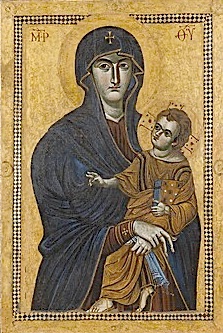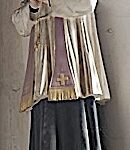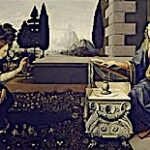Image of Salus Populi Romani, which was restorerd by the Vatican Museum in 2018.
Celebration of Second Vespers on the Anniversary of the Dedication of the Papal Basilica of Santa Maria Maggiore and the Solemnity of Our Lady of the Snows
Homily of Pope Francis at Vespers on Monday, 5 August 2024
in the Basilica of Santa Maria Maggiore
” I greet you, Holy Mother of God “
There are two signs that characterize this celebration: the first is the traditional “snowfall”, which will soon take place during the Magnificat; the second is the icon of the Salus Populi Romani.
These two signs, well interpreted, can help us to understand the message of the Word of God that we have prayed in the psalms and heard in the reading.
The “snowfall“.
Is it just folklore or does it have a symbolic value?
It depends on us, on how we perceive it and on the meaning we give it.
We all know that it evokes the miraculous phenomenon that showedPope Liberius the place where to build the first basilica.
But the fact that this sign is repeated on the occasion of today’s solemnity, inside the Basilica and during the liturgy, invites us to read it rather in a symbolic key.
And so I suggest that we let ourselves be guided by two verses from the Book of Sirach which speak of the snow that God makes fall from the sky, says as follows: “The eye sees the beauty of its whiteness / and the heart is astonished to see it fall” (Sir 43:18).
Here the wise man highlights the twofold feeling that this natural phenomenon arouses in the human soul: admiration and amazement.
When we see snow falling, “the eye admires” and “the heart marvels”.
And this guides us in interpreting the sign of snowfall: it can be understood as a symbol of grace, that is, of a reality that unites beauty and gratuitousness.
It is something that cannot be earned, much less bought, it can only be received as a gift, and as such it is also completely unpredictable, just like a snowfall in Rome in the middle of summer.
Grace inspires admiration and wonder.
Let’s not forget these two words: the ability to admire and the ability to be amazed.
And we must not lose these two capacities, because they enter into the experience of our faith.
The icon of the Salus populi romani.
And with this interior attitude, our gaze can now turn to the second, much more important sign: the ancient Marian Icon, which is, as it were, the jewel of this Basilica.
In it, grace takes on its full Christian form in the image of the Virgin and Child.
The Holy Mother of God. Here grace appears in its concrete form, stripped of any mythological, or magical, or spiritualistic veneer that always lurks in religion.
In the icon there is only the essential: Woman and Son, as in the text of Saint Paul that we have just heard: “God sent forth his Son, born of woman” (Gal 4:4).
The woman is full of grace, conceived without sin, immaculate like freshly fallen snow.
God looked at her with admiration and wonder – even God is amazed… – and chose her as Mother because she is the daughter of his Son: born in him before time, she became his Mother in the fullness of time.
The Child holds the Holy Book with his left arm and blesses with his right; and the first blessed is she, the Mother, the Blessed of all women.
His dark cloak reveals the golden robe of his Son to stand out: in him alone dwells all the fullness of divinity; she, with her face uncovered, reflects her glory.
Let us take some time to go and look at Our Lady.
Let us look at her in silence, seeing all these things, looking at this icon which sanctifies us so much, to all of us. Let’s take some time to go and look at it afterwards.
This is why the faithful come to ask the Holy Mother of God for her blessing, because she is the mediatrix of the grace that always and only flows from Jesus Christ, through the power of the Holy Spirit.
Especially during the course of the coming year, the Holy Year of the Jubilee, many pilgrims will come to this Basilica to ask for the Mother’s blessing.
Today, we are gathered here as a kind of vanguard, and we invoke his intercession for the city of Rome, our city, and for the whole world, especially for peace: the peace that is true and lasting only when it comes from hearts that repend and are forgiven; forgiveness makes peace, because it is the noble attitude of the Lord to forgive. The peace that comes from the Cross of Christ, from his Blood, which he took from Mary and poured out for the forgiveness of sins.
I would like to conclude by addressing the Blessed Virgin with the words of Saint Cyril of Alexandria at the end of the Council of Ephesus:
“I greet you, O Mary, Mother of God, you who brought light, you most pure.
I greet you, Virgin Mary, Mother and servant.
Virgin, through Him who was born of you; Mother, through Him whom you held in your arms. […]
I greet you, Mary, treasure of the earth; lamp that does not go out; from you the sun of justice was born”
(Homily 11: PG 77). Holy Mother of God, pray for us.
And now I invite you, all together – let’s see if you are capable of doing it – all together, to repeat three times:
“I greet you, Holy Mother of God”. All together: [all]
“I greet you, Holy Mother of God”. [all]
“I greet you, Holy Mother of God”.
Another time, louder: “I greet you, Holy Mother of God.”


